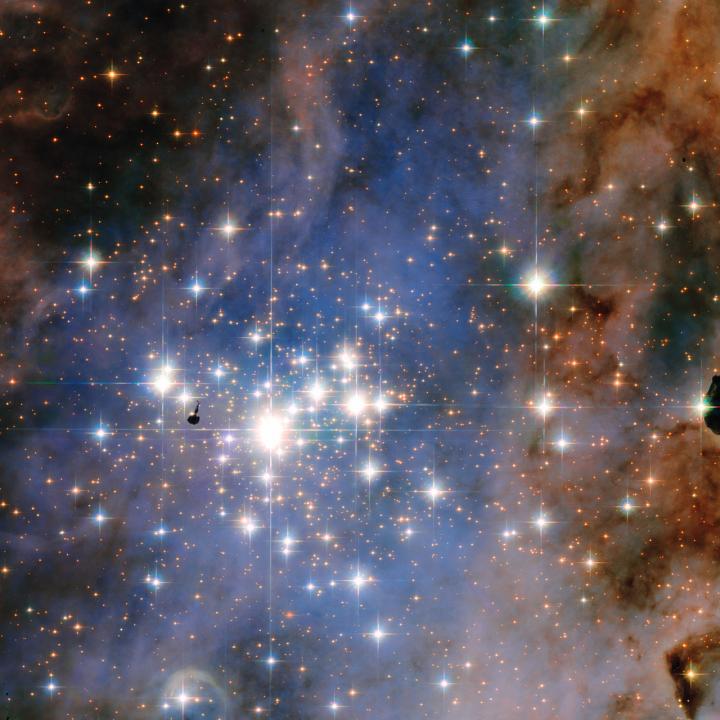Dazzling diamonds

This NASA/ESA Hubble Space Telescope image features the star cluster Trumpler 14. One of the largest gatherings of hot, massive and bright stars in the Milky Way, this cluster houses some of the most luminous stars in our entire galaxy. Credit: NASA & ESA, Jesús Maíz Apellániz (Instituto de Astrofisica de Andalucia)
Around 1100 open clusters have so far been discovered within the Milky Way, although many more are thought to exist. Trumpler 14 is one of these, located some 8000 light-years away towards the centre of the well-known Carina Nebula) .
At a mere 500 000 years old — a small fraction of the Pleiades open cluster's age of 115 million years — Trumpler 14 is not only one of the most populous clusters within the Carina Nebula, but also the youngest. However, it is fast making up for lost time, forming stars at an incredible rate and putting on a stunning visual display.
This region of space houses one of the highest concentrations of massive, luminous stars in the entire Milky Way — a spectacular family of young, bright, white-blue stars. These stars are rapidly working their way through their vast supplies of hydrogen, and have only a few million years of life left before they meet a dramatic demise and explode as supernovae. In the meantime, despite their youth, these stars are making a huge impact on their environment. They are literally making waves!
As the stars fling out high-speed particles from their surfaces, strong winds surge out into space. These winds collide with the surrounding material, causing shock waves that heat the gas to millions of degrees and trigger intense bursts of X-rays. These strong stellar winds also carve out cavities in nearby clouds of gas and dust, and kickstart the formation of new stars.
The peculiar arc-shaped cloud visible at the very bottom of this image is suspected to be the result of such a wind. This feature is thought to be a bow shock created by the wind flowing from the nearby star Trumpler 14 MJ 218. Astronomers have observed this star to be moving through space at some 350 000 kilometres per hour, sculpting the surrounding clumps of gas and dust as it does so.
Astronomers estimate that around 2000 stars reside within Trumpler 14, ranging in size from less than one tenth to up to several tens of times the mass of the Sun. The most prominent star in Trumpler 14, and the brightest star in this image, is the supergiant HD 93129Aa [1]. It is one of the most brilliant and hottest stars in our entire galaxy.
###
Notes
[1] HD 93129Aa is part of the binary star system HD 93129AaAb consisting of HD 93129Aa and HD 93129Ab. HD 93129Aa is an O-type star that is approximately two and a half million times brighter than the Sun, and has a mass 80 times greater. It forms a close binary with another massive star within the open cluster, meaning that the two orbit around a shared centre of mass. With a surface temperature of over 50 000 degrees, HD 93129Aa is one of the hottest O-type stars in the entire Milky Way.
Notes for editors
The Hubble Space Telescope is a project of international cooperation between ESA and NASA.
More information
Image credit: NASA & ESA, Jesús Maíz Apellániz (Instituto de Astrofisica de Andalucia)
Links
- Images of Hubble – http://www.
spacetelescope. org/ images/ archive/ category/ spacecraft/ - Trumpler 14 observed in 1994 by ESO's Very Large Telescope – http://www.
eso. org/ public/ news/ eso0947/
Contacts
Mathias Jäger
ESA/Hubble, Public Information Officer
Garching bei München, Germany
Tel: +49 176 62397500
Email: mjaeger@partner.eso.org
Media Contact
All latest news from the category: Physics and Astronomy
This area deals with the fundamental laws and building blocks of nature and how they interact, the properties and the behavior of matter, and research into space and time and their structures.
innovations-report provides in-depth reports and articles on subjects such as astrophysics, laser technologies, nuclear, quantum, particle and solid-state physics, nanotechnologies, planetary research and findings (Mars, Venus) and developments related to the Hubble Telescope.
Newest articles

NASA: Mystery of life’s handedness deepens
The mystery of why life uses molecules with specific orientations has deepened with a NASA-funded discovery that RNA — a key molecule thought to have potentially held the instructions for…

What are the effects of historic lithium mining on water quality?
Study reveals low levels of common contaminants but high levels of other elements in waters associated with an abandoned lithium mine. Lithium ore and mining waste from a historic lithium…

Quantum-inspired design boosts efficiency of heat-to-electricity conversion
Rice engineers take unconventional route to improving thermophotovoltaic systems. Researchers at Rice University have found a new way to improve a key element of thermophotovoltaic (TPV) systems, which convert heat…



